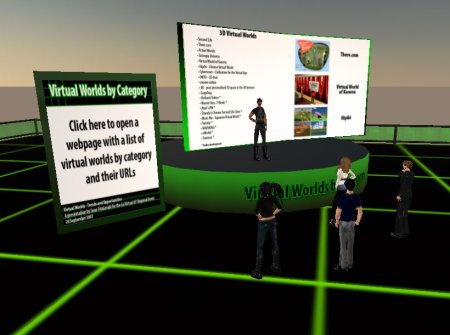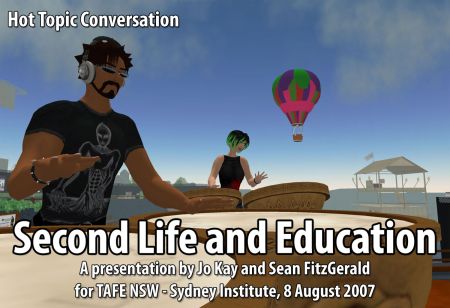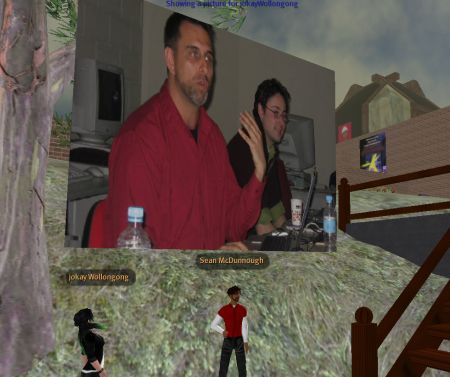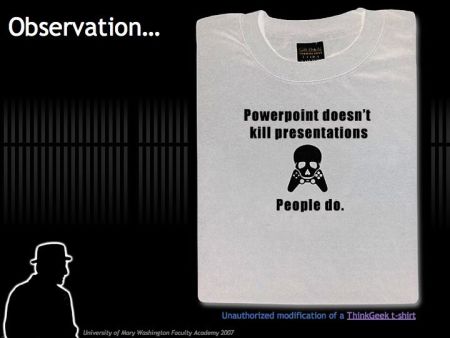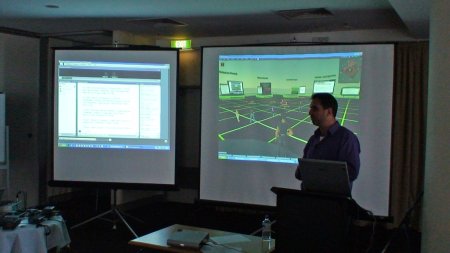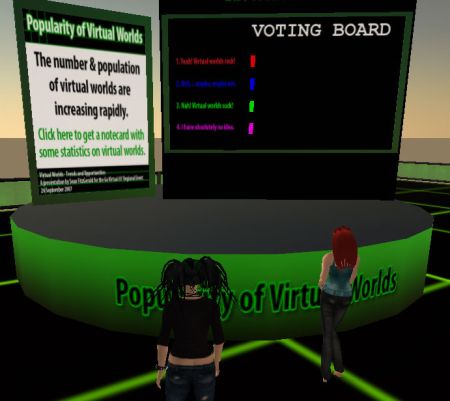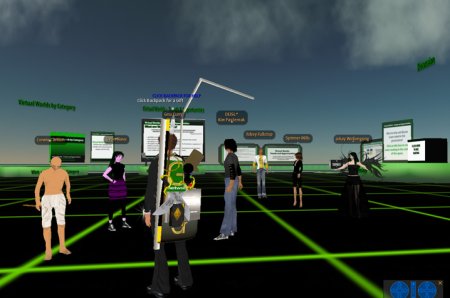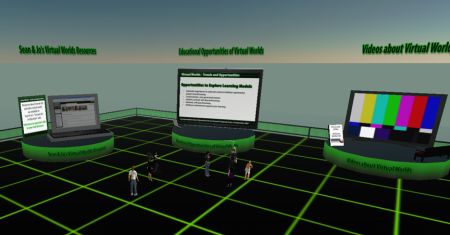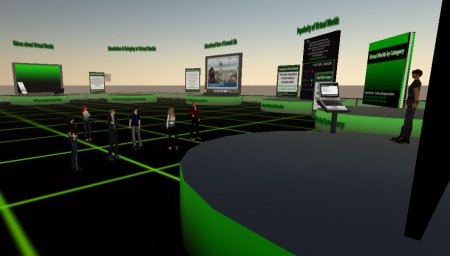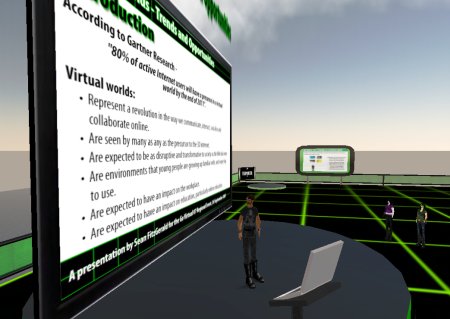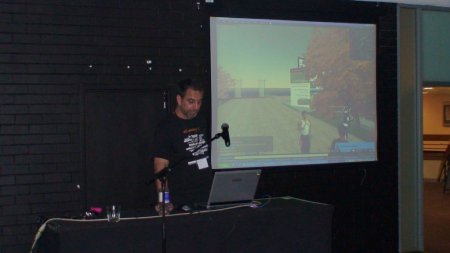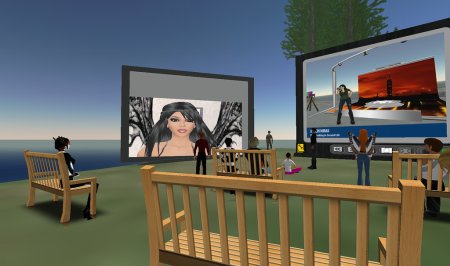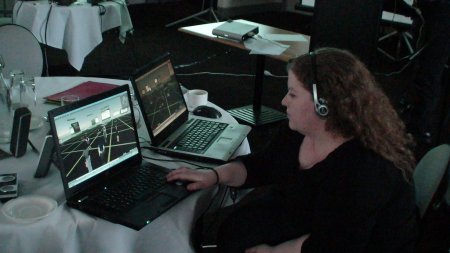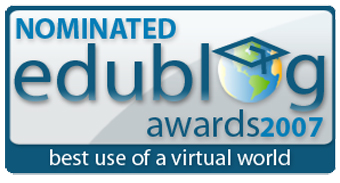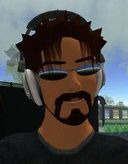This post documents the process I went through in exploring a better way of presenting about Second Life (and other virtual worlds) using Second Life as a presentation platform.
The dilemma
For over a year now, Jo Kay and I have been exploring virtual worlds, in particular Second Life, with a focus on their educational uses and their impact on education. We have developed resources to help educators enter Second Life and we’ve provided training and in-world tours, and given numerous presentations.
However, presenting about Second Life and other immersive virtual environments poses a real (not virtual!) challenge.
For people to fully ‘get’ what an immersive 3D environment like Second Life is really about they need to immerse themselves in the environment, so ideally it’s best to get them in-world and have them experience it first-hand. This of course, is not always possible, because access is not available or because it’s not suitable in a presentation format.
The next best thing to ‘being there’ is a live demonstration, which I do whenever I can, but, once again, access to Second Life is not always available, and when doing online presentations using tools such as Elluminate or Adobe Connect desktop sharing of Second Life doesn’t really work because of the demands on the computer of running both applications simultaneously.
After demonstrations the next best option is to play videos. This method comes closest to giving people a good idea of what Second Life is about in a short space of time without taking them in-world. And there are plenty of good, illustrative videos to chose from. You can see some examples of the videos we use to demo Second Life and virtual worlds on the video section of our wiki.
After video the next best medium is 2D graphics which includes screenshots, Powerpoint presentations and slideshows. These are the most common format used by presenters talking about Second Life.
I usually use a combination of videos and screenshots whenever I can. I use other people’s screenshots, especially Jo’s, as I am not a visual person and I’m just not into taking screenshots or creating graphics. I couldn’t use Photoshop to save my life!
I have only ever (begrudgingly) developed one Powerpoint presentation in my whole career, and only then because it was the required format for an online presentation.
As you can imagine, trying to describe virtual worlds like Second Life with text or verbally is the worst option. You can’t really describe what the experience of being immersed in a 3D virtual world is like.
Now the problem for me is that traditionally I’ve been using text-based wikis as the platform for my presentations.
The old way – using wikis
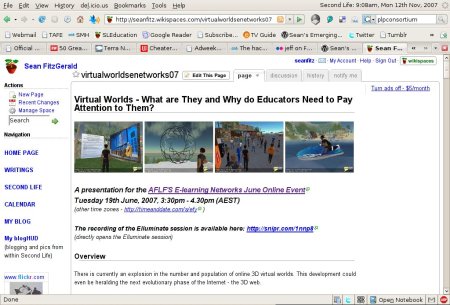
I loved it when I discovered wikis in May 2000. Not only did they provide a quick-and-easy way to develop online resources, but they also suited my presentation style and philosophy about knowledge.
To me knowledge is dynamic and always changing – not something that can be frozen in time. Wikis are a great tool to reflect this idea. You can always be adding to or tweaking a wiki-based presentation right up to, and even during, the presentation.
If you have the wiki open, others can come in and add resources or make corrections (and they often do). This reflects the collaborative nature of knowledge construction, and an acknowledgment on my part that I cannot know everything on a topic.
Of course wikis worked fine while I was presenting about web-based tools and services. I would compile a bunch of links on a wiki and from there launch the websites I wanted to talk about.
Unfortunately Second Life isn’t web based, so as I moved to presenting about Second Life I found I no longer had links to show (other than links to screenshots and videos). I initially persisted with using wikis as my presentation platform for a while (e.g. ‘Virtual Worlds – What are They and Why do Educators Need to Pay Attention to Them?‘), but looking at a wiki and talking about what is in fact a really exciting visual, immersive medium started to feel pretty lame.
So I had me a dilemma, and I had to start thinking about different ways of presenting about Second Life and virtual worlds.
The inspiration
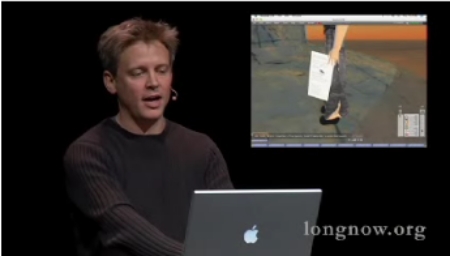
Inspiration came after I watched a video of a presentation given by Philip Rosedale – the visionary creator of Second Life and CEO of Linden Lab – that he gave for the The Long Now Foundation in November last year.
In the presentation Philip used Second Life instead of Powerpoint. He had written his notes on a piece of virtual paper, which he had his avatar hold. He periodically zoomed in to look at the paper in his avatar’s hand whenever he needed to remind himself of the points he wanted to cover.
Watching this gave me the idea of using Second Life as a live presentation platform. And it made sense – why not use the platform itself to demonstrate the platform?
The opportunity
The opportunity came to try out this idea when I was asked to give a keynote presentation called ‘Virtual Worlds – Trends and Opportunities’ for NSW Learnscope’s Regional Event Go Virtual 07! Teaching and Learning in Virtual Worlds for VET in September this year.
Jo was organising the event and agreed to help me experiment with a new presentation format. She offered to build the in-world parts of the presentation for me, as I didn’t have the requisite graphics and 3D building skills to bring my idea to fruition.
A mixed reality event
The idea was to have a mixed reality event, with me presenting in the real world, using my avatar on screen to present from inside of Second Life.
One advantage of this arrangement is that we could include remote participants from anywhere in the world who could participate from inside Second Life. That way the presentation is not restricted only to those in the physical room.
The other advantage is you can include other Second Life residents in the presentation. They can share their experiences of using virtual worlds and Second Life. Jo and I are using this technique more and more. For the real life attendees this showcases the truly collaborative and social nature of 3D immersive environments like Second Life.
It’s also helps to show that Second Life is not just a 3D development environment, but a place that is inhabited by other people from around the world. Many people think Second Life is just a 3D platform for creating 3D exhibitions and simulations until they see other residents in world interacting. Even then they often initially don’t believe the avatars have real people behind them!
The preparation
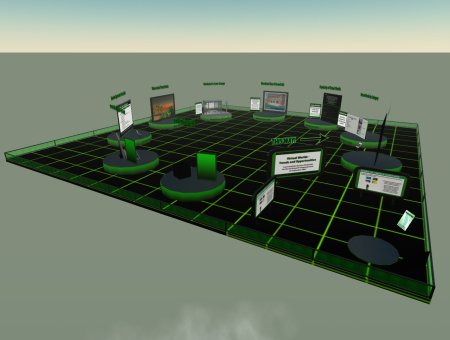
First, we built a sky platform above Jo’s island of jokaydia (I will use the term “sky platform” to distinguish between the actual platform of Second Life and the notion of Second Life as a presentation platform).
The aesthetic chosen was a blend between Jo’s usual green branding aesthetic, and textures reminiscent of the movie ‘Tron’, in honour of my fondness for science fiction. 🙂
I wanted to create a sort of 3D Powerpoint presentation, so we created nine stations on the platform – each one to illustrate a different point or issue. The idea was that my avatar would move around and present from each station, with the in-world audience following me around. I would factor in as much interactivity with the in-world audience as possible.
I wanted to get away from the idea of a linear presentation, so we placed the stations in a circle. I wanted each station to be as stand-alone and self-contained as possible so you could approach the presentation from any point. This reflected my ideas on the non-linearity of knowledge.
In reality it was hard to move fully away from a linear presentation. I couldn’t really get away from a beginning, a middle and an end. I guess many would say a good presentation is a narrative anyway.
The first station starts on the right hand side of the entrance area, and they move in an anti-clockwise direction from there.
I wanted to showcase as many of Second Life’s teaching and information presentation tools as possible, so on the stations I included slide viewers, a video projector, a ‘Thincbook‘, a holodeck to demonstrate rapid scene changes, URL givers and landmark givers, notecard givers, a polling tool and rezzable seating.
In the end, I found it difficult to get away from bullet points, and still ended up with slide viewers on two stations, each with several slides with bullet points. How ironic that in attempting a new form of presentation I ended up doing something that looked at times more like a Powerpoint presentation than what I would normally deliver?!
We had hoped that the whole presentation would be re-usable, something we could pack up and rez elsewhere as needed. This turned out to be more of a scripting challenge than expected and may be too difficult to do. It doesn’t really matter anyway, as I have since decided to abandon the idea of holding further presentations using this system (more on that later).
Jo did an amazing job developing the presentation to my (sometimes very demanding!) specifications. A massive thanks to her for all her hard work!
The limitations of displaying content in Second Life
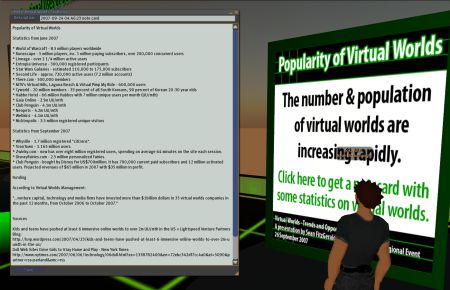
One issue one comes across when giving presentations inside of Second Life is that it isn’t very good at displaying information in-world (yet).
If you want to make a sign, for example, you have to go through the hassle of creating an image with text and graphics on it in a graphics program, uploading the image to Second Life, then adding the image as a texture to the surface of a sign-shaped ‘prim’ (the basic building block of Second Life).
The other option is to create notecards (like the one pictured above) that can be handed out, but these are limited in what they can display.
There are ways to get around these limitations, such as slide viewers, video players, HippoTELL noticeboards and other in-world tools commonly used to display content, but many of these tools are still a bit of a kludge and a hassle to use, and certainly nowhere near as easy to use as the current crop of Web 2.0 tools.
At some stage (hopefully soon!) Second Life will be introducing ‘html-on-a-prim‘. When that happens it should be easy to display web content in-world, including all of our favourite Web 2.0 tools. For me it measn I will be able to display all the web-based content I’ve developed over the years.
The other reason I look forward to the introduction of html-on-a-prim is because then I can take charge of developing and updating my own content myself. Because I have few building skills, and I’m not much of a whiz with Photoshop, Jo did most of the work, and having to rely on someone else to develop my presentation was difficult. Normally I do it all myself.
In-world facilitation
Jo was to assist in-world. When one of us presents using Second Life we always get the other to facilitate. Having an assistant in-world is invaluable as it can be a lot of work dealing with both real world and in-world participants.
We sometimes invite and nominate helpers for our events, as there are often lots of newbies who need plenty of attention… attention I can’t give when I’m focusing on a presentation. We often find though that everyone in-world is pretty helpful to the newbies. This showcases the truly social nature of Second Life and the way that, for the moment at least, most of its residents are only too willing to help out.
Sometimes an in-world facilitator is needed to run interference with other residents. This means dealing with curious residents and explaining to them what’s going on, dealing with newbies who accidentally fly in front of a presentation screen, or dealing with the occasional griefer.
So how did it go?
On the day we were plagued by a bad wireless connection – a nightmare scenario when your presentation depends on quality broadband access. My connection dropped out repeatedly (that’s why I’m missing from the picture above!).
In fact, at times I was reduced to the embarrassing situation of having to read out text from a printout (I have learned to always take backups and printouts of my presentations… I never trust Internet access).
Oh, how ironic! As I mentioned before, text is the lowest preferred option on the hierarchy of media for presenting on Second Life, and about as opposite as you could get to the desired outcome I was trying to achieve in this particular presentation!
Since we’d only managed to get 80% of the sky platform finished by the day of the presentation, and I only got to show about 70% of what we had prepared because of the failing Internet connection, I ended up only showing about 56% (70% x 80% = 56%) of what I had intended to show.
Overall I was pretty disappointed with the result, especially after all the work we put into it (again – another special thanks to Jo who did all the hard work!)
The issue of documentation
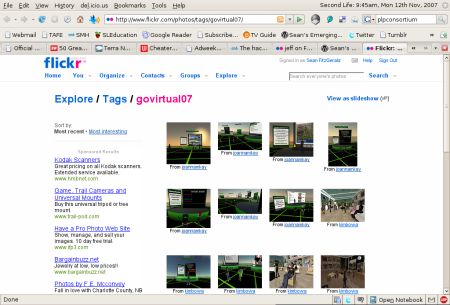
Documenting these types of in-world and mixed reality presentations presents another challenge.
I’ve used the sky platform several times since Go Virtual 07!, but there hasn’t been any documentation, so I have nothing to show for those presentations. This is unusual for me – there is little evidence that I even gave these presentations!
And there is no way for people to get the resources mentioned in the presentation short of going into Second Life and checking out the presentation for themselves.
In the past, documentation was built into the presentation. In fact, my wiki-based presentations serve three functions:
- As my presentation platform, with links to material, including resources and links I want to show, and my own notes.
- A resource attendees can use to do further research and follow-up after the presentation.
- A stand-alone presentation that can be worked through for people who were unable to attend the live presentation.
So this new method of presentation – using Second Life as a presentation platform – needs a new method of documentation.
At first glance it would seem like doing a screen recording would be best, but a screen recording would only capture one perspective – that of my avatar. What about the perspective of the audience, both the face-to-face one and the in-world one? How is that captured?
Second Life events, and especially mixed reality events, are like real life events such as conferences. They really have no authoritative point of view, nor should they.
At conferences you get documentation from multiple points of view… people blog them, take photos and load them to flickr, or record them as audio or video podcasts. Tscenariohey tag them appropriately so that others can find them. Multiple perspectives are represented. This ‘field’ of documentation can then be entered at any point. I believe this is a more accurate and honest representation of reality than any single, edited point of view.
The traditional, single point of view of a news bulletin or documentary edited from a particular perspective is a relic of the broadcast era of media and reflects not only a false and limited perspective of an event, but also the power dynamics of that era. We are now in the era of citizen journalism and the democratisation of knowledge.
The key to documenting events like this is not to find one representative perspective, but to encourage all types of documentation from as many people as possible participating in the event.
Go Virtual 07! documentation
Stephan Ridgway recorded audio from the original Go Virtual 07! presentation and posted it here – Talking VTE Podcast: Go Virtual 07!: Keynote: Virtual Worlds – Trends and Opportunities. This should capture the essence of what I was talking about, but without visuals it may not convey the full context. (No, I haven’t listened to it, I don’t like being recorded and listening back just makes me cringe!)
Stephan links to the Flickr photos tagged with ‘govirtual07’ which include some screen shots (from which I have drawn many of the pics on this post) that may help with context.
One of the attendees at Go Virtual 07! – Dean Groom – took a video of my presentation. Now I hate being videoed at the best of times and, particularly since this presentation didn’t go well at all by my standards, I’ve been too embarrassed to look at it, but if you must, it’s here – TeacherTube – Second Life in Australia. 🙂
There was also a video shot by TAFE that is still being editing. I’m not sure if they are going to do anything with it. If they ever edit it and make it available I will post that here. Apparently it’s not going to be that much better than Dean’s effort though.
Lessons learned
The presentation was a worthwhile experiment, but I wouldn’t do it that way again. I have learned many lessons, but it’s not a model of presentations I would continue with.
I’ve used the sky platform to give several presentations since Go Virtual 07! (why waste all that great work?), and I’ve tried different ways of using it, but it still doesn’t work.
At the end of the day, as novel as the method of presentation was, and despite the fact there was more interactivity with the (in-world) audience, it still ended up looking like a fairly traditional presentation from a ‘sage-on-a-stage’, and in sections of my presentation I ended up talking to bullet points on slides. Sheesh!
The presentation didn’t fully leverage the unique qualities of the immersive 3D world.
They say you should always ‘start with the demo’, and in a sense I did (I was in Second Life and using it after all), but I ended up talking about the topic, when I was in an amazing world where I could actually show what I was talking about.
And, as I mentioned earlier, I’ve also learned that I need to find ways to take more control over my content, so I am not relying on other people as much.
Next – my presentation at eLearning07
In early November I presented The Educational Potential of Virtual Worlds at NSW LearnScope’s annual conference – eLearning07.
This time I didn’t do the presentation on the sky platform. Instead, I moved around – I wanted to use all of Second Life as a presentation platform.
I placed a slide viewer and video player on the ground, on Jo’s personal island.
We did a tour of jokaydia, including the Hairdressing Salon and LearnScope Teams in-world poster display, and ended up on NMC Campus. I would have taken people to at least one more location, but time was against us.
I stopped where appropriate to show slides and a video, talk to guest speakers and pull resources out of my inventory to be rezzed and displayed in context when they were needed.
This approach also reflects my belief that – just as in real life – learning can, and should, happen anywhere, not just designated learning spaces such as classrooms or ‘learning environments’ built by instructional designers. All of Second Life is a learning environment.
I invited several educators – Konrad Glogowski, Westley Field and Alan Levine – to share with us what they have been up to, or plan to get up to, in Second Life, and their views on the educational potential of Second Life and virtual worlds.
Jo and I have found that inviting others to contribute has several advantages:
- It adds another dimension to the presentation.
- It takes the pressure off me to talk all the time.
- I don’t need to be the expert in educational uses of virtual worlds and Second Life (remembering I’m actually a researcher/consultant/trainer/presenter, not a practitioner – getting practitioners to speak in their own language works really well).
- It leverages and demonstrates the social and collaborative qualities of the Second Life platform.
There were some hitches on the day (aren’t there always with presentations in Second Life?!), and Jo was called away to attend to something else so couldn’t be in-world to assist as she normally would have, but overall I felt that this presentation worked a lot better than the Go Virtual 07! one.
And a big thanks to Gnu Curry who stepped in and helped out!
eLearning07 presentation documentation
Stephan Ridgway did another amazing job of recording and editing the audio of my presentation and posted it here – Talking VTE Podcast: elearning07: The Educational Potential of Virtual Worlds.
As for images there are only a few, with Konrad Glogowski taking a few screenshots, and Alan Levine taking this one and this one. These pictures only show the section of the presentation held on Jo’s personal island – illustrating the need to organise thorough documentation of an in-world event to give a more accurate impression of what happened.
Where to from here?
Both Jo and I will continue to explore the ideas discussed in the post. (That’s her in the picture above supporting my Go Virtual 07! presentation – thanks again Jo!)
I enjoy using Second Life as a presentation platform, and I will be taking the many lessons learned during my experiments and continue to develop my presentation style.
Visit the presentation in the sky
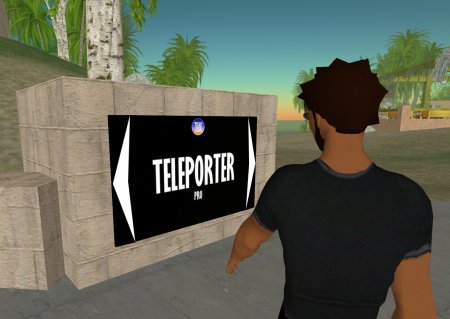
Finally, the ‘Virtual Worlds – Trends and Opportunities’ presentation for Go Virtual 07! on the sky platform will be there for a while (until we need the prims for something else!), so if you get a chance, check it out. We put a heck of a lot of work into it, and it’s a bit of a shame that not many people have seen it yet – an issue this blog post, in part, is intended to hopefully rectify.
To find the presentation you need to go to jokaydia’s landing point, look for the Teleporter sign and select Sean FitzGerald’s Virtual Worlds Presentation.

